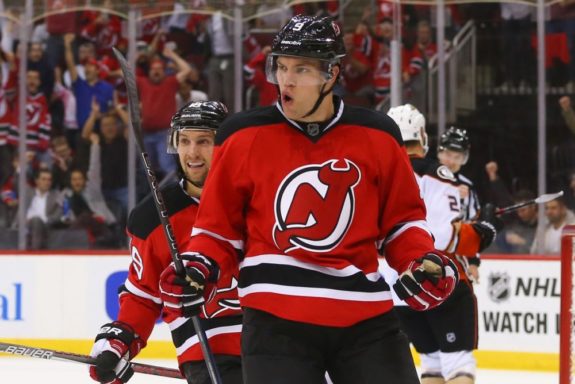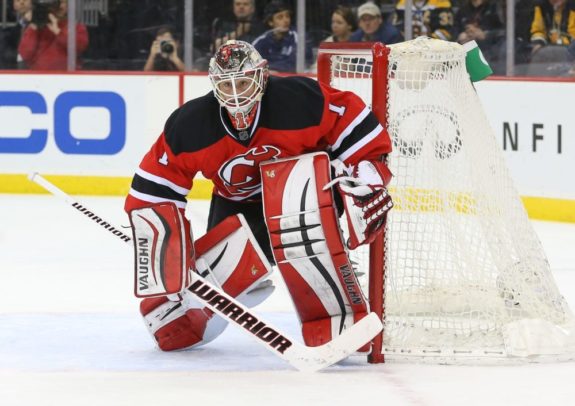One of the most difficult sights in professional sports is when strings of losses come together. It’s not pleasant for the players, the coaches and especially the fans. That is why the New Jersey Devils‘ recent slump, a 1-8-1 record in the last 10 games, can be so dreary for the whole organization and fanbase.
But what exactly is the problem in New Jersey? The offense usually plays the role of scapegoat when things go awry for the Devils but are they once again the main culprit? The defense and goaltending have been out of sorts lately as well. On the surface, it’s not entirely clear where the problem lies. Without finding any ailments, all proposed solutions would be subject to criticism and are likely to fail.
Offense
It would be remiss for any piece about the Devils’ struggles of late not to include the team’s scoring near the top of the list. Over the last 10 games, the team has scored just 1.6 goals per game. For comparison’s sake, that number is less than the team average in 2014-15, 2015-16 (when they finished last in the league) – and any other 10 game span over the course of this season.

But not every player deserves a fair share of the blame — some skaters have played up to their own par over this period. Taylor Hall, Kyle Palmieri and Travis Zajac, for example, have notched 11, 10 and nine points in their last 14 games, respectively. For Zajac and Hall, that type of production is more of the same this year.
For Palmieri, in contrast, those 10 points are a clear digression from his early season production (where he started with one fewer point in five more games) and are more in line with expectations after a breakout performance in 2015-16.
Rounding out the top-six, Adam Henrique has been solid, while Michael Cammalleri and PA Parenteau have regressed back to the mean but are both still producing. The problem, as usual, is not being caused by the top-six. Instead, most of the team’s woes come from a dormant bottom-six.
Successful offenses find contributions outside of their top-two lines. The Devils have failed to do that over the last five years and that has been a big reason why the team has not sniffed the playoffs since 2011-12. Looking around the bottom-six the situation becomes clearer. Beau Bennett is on a nine-game scoring drought. Devante Smith-Pelly hasn’t picked up a point in 10 games. Zacha hasn’t done anything of note in nine games.
| Games Played | Points | Points in last 10 | |
| Beau Bennett | 29 | 7 | 0 |
| Devante Smith-Pelly | 29 | 6 | 0 |
| Miles Wood | 16 | 4 | 3* |
| Nick Lappin | 27 | 7 | 0 |
| Pavel Zacha | 30 | 5 | 0 |
| Sergey Kalinin | 27 | 2 | 1 |
| Vern Fiddler | 35 | 3 | 0 |
* = Points scored as a member of the top-six
Evidently, the Devils have struggled immensely to stimulate production from the bottom of the lineup. One goal in 10 games from seven forwards is unacceptable and a major reason why the team has struggled to date.
Defense
For the first time in over 10 years, the Devils ice one of the worst team defenses in the NHL. The team’s goals against, 2.94 and is the 24th ranked in the league — a far cry from last year’s mark of 2.46.

(Amy Irvin / The Hockey Writers)
From a personnel standpoint, the defense is quite different than last year. Yohann Auvitu, Kyle Quincey and Ben Lovejoy are current fixtures on the backend and gone are the likes of Adam Larsson, Eric Gelinas and David Schlemko. Returning starters include Andy Greene, Jon Merrill, John Moore and Damon Severson.
It doesn’t help matters that Adam Larsson, arguably the Devils’ best defensive-minded blueliner, was traded and is currently thriving in Edmonton. NHL.com’s Tim Campbell wrote a piece on the matter and credits Larsson for the defensive transformation in the Oil Capital.
In that they both shoot first and ask questions later, Auvitu for Schlemko seems like a lateral movement that should have little impact on the defense’s ability to suppress shots. But Kyle Quincey and Ben Lovejoy, two blueliners that specialize in taking chances away from the opposition, have been on the ice for a lot of the Devils’ goals against this season: 2.69 GA/60 for Quincey is one of the worst figures on the defense and well below average.
Unfortunately, while John Hynes and Ray Shero searched for the right type of player for the defense – ones who can stifle opponents’ creativity in the offensive zone – they did not pick up the right talent. Both have struggled to make their presence felt in the lineup and are unable to fill the void they were brought in to occupy.
https://www.youtube.com/watch?v=GmUkhOuMXds
There is always the possibility of a trade. Lovejoy is unlikely to go anywhere given his two-year deal and the fact that Shero rushed out to bring in the former Pittsburgh Penguin on July 1. Quincey is not so immune, on the other hand. He was brought in just before training camp and never dazzled while there. He has been steady, but unspectacular, on a team that needs defensive help. He still has an impressive resume to his name, though.
Moving a defender out of the lineup will provide Hynes and Shero with the opportunity to see what they have in some of their youth currently toiling in Albany. Seth Helgeson, Steven Santini and Joshua Jacobs are all looking for an opportunity to play in New Jersey and they won’t be able to make the transition if the path is blocked.
Special Teams
As surprising as it may seem given the team’s offensive struggles, New Jersey tends to find itself near the top of the board in powerplay efficiency, usually at or above the 20% mark. In 2016-17, however, the team is just over 15% and is 23rd in the NHL. Leaving goals on the table on the man-advantage can doom a team, especially one already struggling to score when even-strength.

As is the trend, the top-six are the team’s best scorers both in volume and efficiency. Damon Severson has been one of the league’s better defensemen on the man advantage, 12th in points/60minutes.
But the positives mostly stop there. The Devils powerplay has been cold and much of that is a result of the team’s inefficient forwards, like Beau Bennett, Pavel Zacha and Devante Smith-Pelly. That trio has amassed just seven points in more than three hours of powerplay time. Hall has the same number of points on his own in less than half the time on ice.
Clearly, there needs to be a roster adjustment on the man advantage. The Hockey Writers’ Michael Gwizdala wonders if Patrik Elias could bring about a turnaround for the Devils’ faltering power play unit.
The penalty kill is currently above average and has rebounded well after a rough patch near the beginning of the season. Travis Zajac and Adam Henrique are second and third, respectively, in goals against per 60-minutes when shorthanded. That is an incredible feat and has been a huge reason why the Devils usually go unscathed on the penalty kill — Dwight King of Los Angeles is above them.
Goaltending
When the Devils traded for Cory Schneider, it seemed like a foregone conclusion that goaltending would not be a problem for at least 10 years. That hasn’t been the story in 2016-17. The defense is partly at fault for allowing so many shots, but Schneider hasn’t done his part to keep those shots out of the net.

Of the 40 NHL goalies who have played in at least half of their team’s games, Schneider is the fifth worst in save percentage with .904. He has never played this badly in his entire career and his recent string of play has been dreadful, with a .887 mark in his last 10 games. That performance is subpar even for a backup, let alone a franchise goalie.
A true testament to the Devils’ dichotomy at goalie, Keith Kinkaid, has been nothing short of phenomenal in the 2016-17 season. His .930 save percentage is the eighth-best among goalies playing at least five games. Most recently, he racked up 40 saves in a win over Washington.
https://www.youtube.com/watch?v=wtu_ktpBNsU
The key to the Devils’ goaltending is not to trade Schneider but instead to give him a break. He’s cold as ice lately and still plays the vast majority of the Devils’ games. With the team reeling and a far cry from contention, why not give Schneider a break in exchange for fresher legs in net?
Though 2016 is over, the 2016-17 season isn’t even halfway done. The Devils can fix these problems and still stand a chance to make the playoffs. Maintaining status quo will not get them far and could lead to another bottom-10 finish. Ultimately, Hynes and the rest of the coaching staff will need to change their tune while continuing to motivate and energize their players if they want to right the ship and contend in 2017.